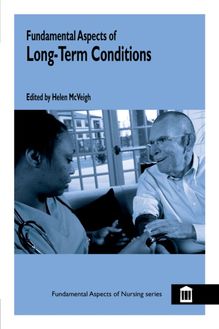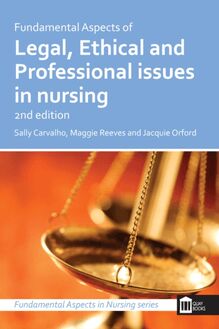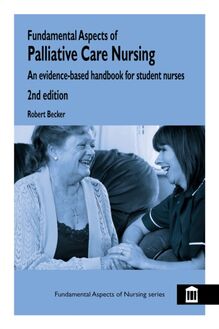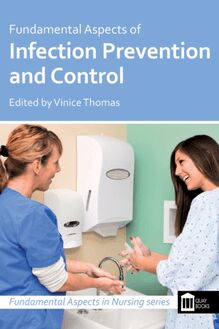Fundamental Aspects of Infection Prevention and Control , livre ebook
108
pages
English
Ebooks
2020
Vous pourrez modifier la taille du texte de cet ouvrage
Obtenez un accès à la bibliothèque pour le consulter en ligne En savoir plus
Découvre YouScribe et accède à tout notre catalogue !
Découvre YouScribe et accède à tout notre catalogue !
108
pages
English
Ebooks
2020
Vous pourrez modifier la taille du texte de cet ouvrage
Obtenez un accès à la bibliothèque pour le consulter en ligne En savoir plus
Publié par
Date de parution
18 août 2020
Nombre de lectures
2
EAN13
9781856424448
Langue
English
Fundamental aspects of infection prevention and control
Edited by
Vinice Thomas
Published by
Quay Books Division, MA Healthcare Ltd,
St Jude’s Church, Dulwich Road, London
SE24 0PB
© MA Healthcare Limited 2011
All rights reserved. No part of this publication may be reproduced, stored in a retrieval system or transmitted in any form or by any means, electronic, mechanical, photocopying, recording or otherwise, without prior permission from the publishers.
Edited by Jessica Anderson
Series editor: Dr John Fowler
Digital version converted and distributed by
Andrews UK Limited
www.andrewsuk.com
Note
Healthcare practice and knowledge are constantly changing and developing as new research and treatments, changes in procedures, drugs and equipment become available.
The author and publishers have, as far as is possible, taken care to confirm that the information complies with the latest standards of practice and legislation.
List of contributors
Rachel Ben Salem BSc(Hons) Microbiology, Dip(Infection Control), PGCert(Academic Practice) is Senior Infection Control Nurse, Kings College Hospital NHS Foundation Trust, London
Christine Berry RGN is Infection Prevention and Control Nurse, Calderdale and Huddersfield NHS Foundation Trust
Dorothy N Chakani Dip(HEN), CertSpmic, RGN is Senior Infection Control Practitioner, West Sussex Health, West Sussex
Andrea Denton MA, MSc, BSc(Hons), DPSN, RNT, RGN is Infection Prevention and Control Nurse, Calderdale and Huddersfield NHS Foundation Trust
Carole Hallam MSc, BSc(Hons), CertHeEd, RGN, RMN is Assistant Director of Infection Prevention and Control, Calderdale and Huddersfield NHS Foundation Trust. She is also Branch Co-ordinator for the Infection Prevention Society. Currently Associate Portfolio Manager for the Department of Health National Healthcare-Associated Infection Team
Emily Hoban is Assistant General Manager, Specialist Services, Southport and Ormskirk Hospitals NHS Trust. She is an accredited trainer for the Chartered Institute of Environmental Health. Currently Cleaning Specialist for the Department of Health National Healthcare-Associated Infection Team
Louise Hodgson BSc, Cert IC (University of Leeds), RGN is Team Leader, Infection Prevention Team, Wakefield Distict Comunity Healthcare Services
Annette Jeanes MSc, Dip(N), Dip(IC), RN is Director of Infection Prevention and Control, Consultant Nurse Infection Control, University College London NHS Foundation Trust
Sheila Loveridge BSc, RGN, Dip HEd, Dip IC, MSc (Public Health) is Consultant Nurse, Infection Control, Western Sussex Hospitals NHS Trust, Worthing
Christianne Micallef BPharm(Hons), MPhil, PhD, MRPharmS is Lead Specialist Antimicrobial Pharmacist, Queen Elizabeth Hospital Kings Lynn NHS Trust. Currently Specialist Project Support Practitioner for Antimicrobial Prescribing for the Department of Health National Healthcare-Associated Infection Team
Sandra Mogford DipHE, RN (Adult) is Infection Prevention and Control Nurse, Calderdale and Huddersfield NHS Foundation Trust
Vinice Thomas MBA, BSc(Hons), PGDipEd, RGN is Assistant Director of Nursing/Clinical Governance and Director of Infection Prevention and Control, Harrow PCT. Currently Portfolio Manager for the Department of Health National Healthcare-Associated Infection Team
David Tucker BSc (Infection Prevention) is Deputy Director of Infection Prevention and Control, Guy’s and St Thomas’ NHS Foundation Trust, London and Honorary Lecturer, King’s College London
Foreword
Infection prevention is a responsibility everyone shares, and the reduction of healthcare-associated infections (HCAI) remains a duty of every NHS organisation. Good hand hygiene, high standards of cleanliness, prudent antimicrobial prescribing and effective patient screening are all vitally important in the fight against HCAIs.
There has already been a significant reduction across the NHS in some HCAIs, specifically MRSA and Clostridium difficile . However, there remains capacity for these and other infections to be reduced further.
Within the pages of this book, you will find information and guidance, with tools and examples of successful infection prevention and control practice. These will help you, your organisation, and patients and visitors to play a part in reducing infections. By reducing infections, we can save lives and reduce the unnecessary pain and suffering caused to patients, their families and loved ones.
Patients and service users expect high standards of safety and cleanliness in their care. Reducing HCAI rates and communicating these results will help those you care for have confidence in the service you provide and reduce their fears and anxieties. The prevention and control of infections is not just a professional duty but also a clinical and managerial responsibility.
HCAIs cost the health service around £1 billion per year. In addition, evidence suggests that service users with MRSA bacteraemia spend on average an additional 10 days in hospital, whilst those with Clostridium difficile spend an additional 21 days in hospital. Reducing HCAIs helps the NHS make the most of its resources and deliver more for its users.
All healthcare staff have a duty and responsibility to provide an environment within which clean, safe care can be delivered. Reducing infection improves care and overall health outcomes for patients.
Find out what you and your organisation can do to help tackle infections.
Professor Janice Stevens CBE
1. Introduction
Vinice Thomas
Purpose
The purpose of this chapter is to set the context for infection prevention and control within health and social care settings, and to provide a brief overview of the book.
Learning outcomes
By the end of this chapter, you will have learned: The importance of infection prevention and control. The key components of effective infection prevention and control. How to use this book as a tool for personal and professional development.
Introduction
Infection control is an exciting and rewarding aspect of patient care which has evolved over the past decade. It is exciting because of the ongoing medical advances and discoveries that have helped to eradicate or control diseases which, in previous years, would have inevitably resulted in fatalities. It is rewarding because, through good stewardship of antibiotics, consistent application of good hand hygiene, and good management of medical devices and other elements of patient care, recovery from life-threatening infections is possible. Job satisfaction for many is found in the knowledge that one has contributed to a positive outcome be it a speedy recovery or a peaceful and dignified end of life.
In the quest to deliver high standards of care, healthcare workers have strived to overcome barriers to quality care, with the reduction of infections being a key challenge. One commonly held view was that infections were inevitable when patients were admitted to hospital for treatment. As a result significant reductions in healthcare associated infections (HCAIs) had, until recently, been considered to be an unachievable goal. By 2008, there was a significant reduction in methicillin-resistant Staphylococcus aureus (MRSA) and an improvement in Clostridium difficile rates of infection (Department of Health 2008a). Although these two infections received a great deal of focus and media attention, it was clear that healthcare organisations were also grappling with other HCAIs. However, lessons learnt from tackling MRSA were transferable to other infections. For instance, the elements of care found to be effective in reducing MRSA and Clostridium difficile rates, such as good hand hygiene, were applicable to all of the other infections. Indeed some hospitals reported an improvement in other HCAIs as a result of improved practices for MRSA.
Although the causes and management of infections are multifaceted and at times complex, national and global work on reducing HCAIs has highlighted some key factors that can achieve significant results. This involves the consistent application of a number of actions that together make the reduction of infections achievable. These include the appropriate use of antibiotics, management of invasive medical devices, and cleanliness of the environment, to mention but a few. However, the activities must be applied consistently by all staff. This means there is no room for deviating from what is known to be best practice without a real danger of harm to patients.
In 1859, Florence Nightingale, the founder of modern nursing, stated:
It may seem a strange principle to enunciate as the very first requirement in a hospital that it should do the sick no harm.
(Nightingale 1992)
This can be applied to every setting where care is given to patients or clients, be it in the community, in care or nursing homes, in acute settings within busy wards, or specialist areas such as intensive care units or burns units. Despite various competing priorities, it is important that patients/service users receive care that has no negative effect. As Professor Sir Ian Kennedy expressed aptly:
Safety cannot ever be allowed to play second fiddle to other objectives that may emerge from time to time ... it is the first objective.
(Healthcare Commission 2006)
Infection control must be at the heart of safe care, and should be an integral part of daily activities undertaken by staff. No staff member should be excluded from contributing to the control of infections (Healthcare Commission 2007).
Throughout the history of health and social care, there have been incidents where outbreaks of infections have h



